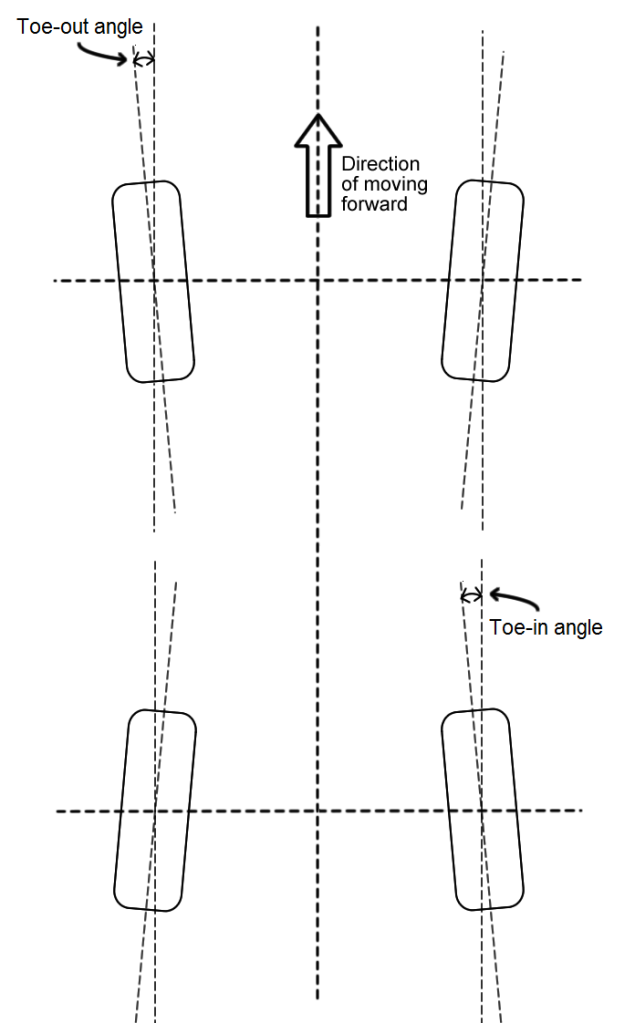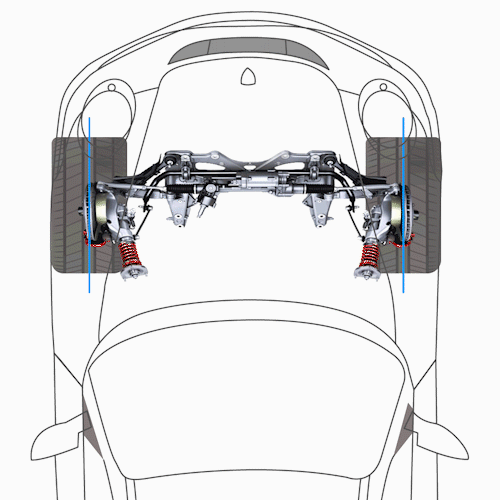
Introduction
Toe is one of the characteristic angles for a car’s geometric setup along with camber and caster. This is the inclination given to the wheels of the same axle with respect to the longitudinal centreline of the vehicle. In practice, the wheels are not perfectly parallel to each other, although it is a minimum angular inclination, not visible by eye.

Toe is the angle of the wheel when viewed from above. The best way to envisage toe is to think of the wheels steering inboard or outboard of the car. This is toe angle. The GIF below shows changing toe angle from above. Toe in, or positive toe (+), is where the front of the wheel points in towards the centre of the car from a top view. Toe out, or negative toe (-), is when the front of the wheel points out towards the outside of the car from a top view. There are many different ways to set toe on the front and rear wheels and not one rule applies to all cars.

What is the purpose of adjusting the toe of the tires?
The wheels generate a moment of force, thanks to which each of them tries to “pull” the car in its own direction. This situation is apparently stable, as the forces produced on the two sides of the car cancel each other out. However, if a wheel hits a bump, the other wheel gains more traction, resulting in a loss of stability. The wheels tend to steer on their own, with no steering wheel input from the driver, and the car starts to skid and requires repeated line corrections. This phenomenon is identified with the term “bumpsteer”.
To avoid the need for constant steering action, it is generally sufficient to aim the two wheels slightly inwards. The wheels will continue to create the opposing forces, but the system will be stable. This system, by acting on all elements of the suspension and on the tires, has a positive effect on driving the car. It also has its drawbacks: it causes slight understeer when cornering.
Remember: toe set in static conditions is subject to more or less small variations when you switch to dynamic conditions (vehicle in motion), that is to say to the variation of the suspension travel, due to the effect of the drive torque applied to the wheels, as the angle varies of steering when changing direction (Ackermann Effect), etc …
The toe angle in motorsports
The car manufacturer’s adjustment of the toe angle is a compromise that takes into account the safety of the car when traveling on different surfaces. What is the geometry of the driving system in motorsport?
In GT racing, where rear-wheel drive cars dominate, diverging front wheel geometry is often adopted. In addition, a slight toe-in on the rear wheels is set.
The situation is different in rallies, where the geometry of the wheels in the car is adapted to the different conditions of the surface. On smooth, asphalted surfaces, with sweeping and fast curves, the convergence on the front axle is done on positive values, while the rear axle is adjusted to the so-called zero. The front and rear axles are adjusted divergently on soft gravel surfaces, where the car almost never travels linearly. Thanks to this, an immediate reaction to the movements of the steering wheel is achieved, however, to the detriment of driving comfort on a straight line.
The toe angle on Assetto Corsa Competizione

In the ACC screen for tire tuning, the input parameter “toe”, is strictly correlated to an offset value (called “toeOutLinear” within the setup json file) through the which, similarly to what happens in common practice, the actual (desired) convergence value is obtained. As clarified by Kunos Simulations (pankykapus) on the ACC forum:
- the toe value set in the tire setup screen is the real one obtained when the car is stationary in the garage (therefore on a flat surface and in static conditions); when the car is in motion the value of the toe changes slightly with the compression and extension of the suspension on a bumpy surface this can even give rise to “bumpsteer” phenomena;
- the relationship between the offset value and the actual toe value depends on the geometry of the steering arm and its position relative to the wheel hub.
The image below shows the intervention mode on the steering tie rod – track rod end for the adjustment of the convergence in real cars and, in particular, in the Lotus Elise (the adjustment indicated by the red arrow represents the “toeOutLinear” contained in the ACC setup json file).

In the following figure it is possible to observe in detail the connection of the steering tie rod with the track rod end.

On Assetto Corsa Competizione, as well as in real cars, the toe adjustment can help improve the car’s handling characteristics.
Having positive toe on the front wheels will give the car more stability when entering corners, but can cause more understeer. Positive toe-in on the rear wheels will help increase the overall stability of the car.
The negative toe angle at the front will make the car more responsive to steering inputs, but can result in more oversteer. On the rear wheels, toe-out will make the car unstable and is generally not recommended under any circumstances.
Kunos specified (see here) that in ACC, on the tire setup screen, the angle unit is decimal; therefore, for example, a convergence of 0.4 decimal degrees corresponds to 0° 24′ 0″ sexagesimal (0 degrees, 24 minutes and zero seconds). For the conversion from decimal degrees to sexagesimal degrees click here.
Below are the changes to be made to the toe angle for solving the main problems with car handling and tire wear.
Oversteer
- corner entry: reduce negative toe at the front;
- cornering: reduce negative to at the front;
- corner exit: increase the positive toe at the rear.
Understeer
- corner entry: increases the negative toe at the front;
- cornering: increases the negative toe at the front;
- corner exit: decrease the positive toe in at the rear.
Poor top speed
- reduce the toe angle, front and rear, approaching zero.
Overheating and/or excessive tire degradation
- reduce the toe angle, front and rear, approaching zero.

